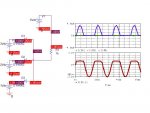Gary Glaenzer
Member
Voltage of ideal diodes in parallel?
If you have voltages applied as shown (assuming those are referenced to ground), the voltage at the junction of the diodes' anodes will 2.3 V, assuming ideal silicon diodes with a 0.7V drop.
Therefore, the two bottom diodes will be reversed biased and can be ignored.
The current would be 2.7 V / 1000 ohms or 2.7 mA.
At least, that's what I think the question is meant to ask.
Your mileage may vary...............
I have this question in my study material and I can't figure out what it is asking. It wants the voltage V or total voltage with diodes in parallel, and I can't figure it out. Here is a diagram of the question.
If you have voltages applied as shown (assuming those are referenced to ground), the voltage at the junction of the diodes' anodes will 2.3 V, assuming ideal silicon diodes with a 0.7V drop.
Therefore, the two bottom diodes will be reversed biased and can be ignored.
The current would be 2.7 V / 1000 ohms or 2.7 mA.
At least, that's what I think the question is meant to ask.
Your mileage may vary...............

